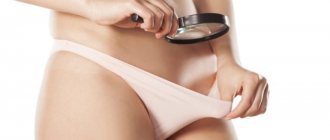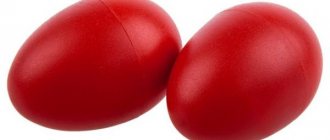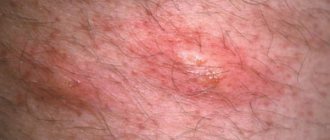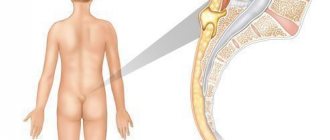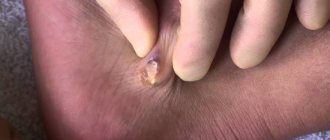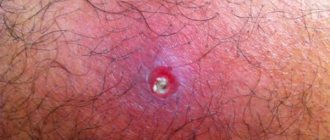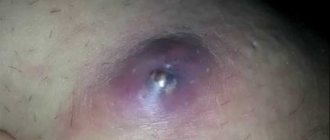How to treat boils in the groin, scrotum, buttocks, penis? Treatment of boils in the intimate area in men involves the use of ointments, tablets, and folk remedies.
We will tell you what causes the appearance of boils in the groin, what are the symptoms of this disease and methods of its treatment.
This inflammatory process develops as a result of a staphylococcal infection entering the hair follicle. Staphylococcus bacteria are normally present on the surface of the skin of any healthy person.
Their approximate ratio to the number of other microorganisms is about 10%. Staphylococcus aureus is found on the skin of both the face and the entire body, including in the genital area and in the groin area.
As a rule, a boil in the groin area can be caused by the following reasons::
- decreased immunity and the body’s inability to independently suppress the causative agent of the inflammatory process;
- uncontrolled use of immunosuppressants and drugs from the group of cytostatics;
- urogenital diseases;
- hypothermia of the body;
- the presence in the perineum of a nutrient medium for the proliferation of pathogenic flora - hemorrhages, microtraumas or dead tissue;
- disturbance of local blood circulation;
- failure to maintain personal hygiene in the intimate area;
- increased sweating;
- hormonal imbalance;
- lack of vitamins;
- pediculosis of the pubis.
One of the most common reasons for the development of boils on the pubis is wearing tight synthetic underwear, which creates friction and injures the skin. Even minimal damage to the epidermis becomes an “entry gate” for infection.
The etiological mechanism of this disease is triggered by a number of factors:
- dysfunction of the immune system, the inability of the body’s defenses to suppress the activity of the pathogen;
- taking certain medications (immunosuppressants, cytostatics, etc.);
- infectious diseases, especially of the urogenital system. Sexual diseases (gonorrhea, trichomoniasis, mycoplasmosis, herpes) contribute to the appearance of boils in the groin;
- hypothermia of the body. This factor is a common cause of the appearance of a boil in the groin area, especially in the recurrent form of the disease. Basically, this refers to hypothermia of the lower body (swimming in a cold body of water, clothing out of season, etc.);
As the disease progresses, the bulb fills with pus. Most often, during the process of inflammation, a person experiences pain.
Symptoms and localization of boils in the intimate area in men
An abscess most often occurs in places where sebaceous glands accumulate, in areas that require more careful hygiene. Often there are boils on the genitals, breasts, and buttocks.
Subcutaneous discomfort appears first. Pain and swelling at the site of the future boil increases over several days. Redness and burning accompany the formation of an abscess.
The peculiarity of boils in intimate places is significant pain due to the presence of many nerve endings. The pain does not subside until the boil opens.
If the boil is single, then usually it does not change the general condition. However, large or multiple ulcers can cause fever, general malaise, and headache.
On the pubic area
Improper shaving, microtraumas, and lack of hygiene become the primary cause of boils.
Ulcers on the pubis can lead to swelling of nearby tissues and lymph nodes. Particular sensitivity of the genitals entails great pain.
A boil on the pubic area can serve as a sign of other diseases, including inflammatory processes of the pelvic organs and sexually transmitted diseases.
The genitals are supplied with many blood vessels, so the likelihood of infection entering the blood is multiplied many times over.
On the penis
The appearance of an abscess on the penis is provoked by the same reasons as on other groin areas. Another factor for the addition of a staphylococcal infection is microtrauma on it.
The latter can appear when there is insufficient amount of natural sexual lubrication. The inflamed foreskin, the lack of integrity of its structure, serves as a place for bacteria to penetrate.
The development of a boil on the testicles and scrotum is favored by ignoring the rules of personal hygiene and unprotected sexual contact if the partner has an infection.
Since the genitals in men are the most sensitive area, the pain here is more intense. They can be transmitted to other genital areas - eggs, scrotum.
Patients experience painful erections, and it is often painful to urinate. The head of the penis is not susceptible to the appearance of boils due to the absence of hair follicles.
On the buttocks
A boil on the buttocks is one of the most unpleasant places to localize. The patient experiences pain when moving, cannot sit or lie on his back.
Inflammation in the buttock is associated with local hypothermia, as well as poor sanitation in this area. The most dangerous are internal boils, which are often found on the buttocks.
Cheerios on the pubic area, in the anus, between the buttocks, on the testicles and other places
Abscesses form according to a standard pattern, no different in symptoms, causes, and course of the disease from abscesses in other places. In especially severe cases (severe pain in the inflamed area, fever, weakness), consult a doctor immediately.
What does a boil on the genitals look like (photo)
Prevention
Having once experienced all the delights of a boil in the groin area, it is unlikely that anyone will want it to appear again. Some preventive measures aimed at eliminating the cause of a boil in the groin will help eliminate the likelihood of relapse:
- Compliance with hygiene rules. This concerns personal hygiene and home cleanliness.
- Normal sleep. Getting enough sleep helps you cope with all pathologies more effectively.
- Healthy eating. It is necessary to constantly eat foods rich in vitamins and minerals.
- Protection against hypothermia.
- Timely treatment of injuries and scratches in the groin area. It is recommended to treat them with antiseptic agents.
The combination of these measures will eliminate the risk of an inflammatory process in the body.
Stages of development of furunculosis
The disease occurs in several stages. The ideal start for starting treatment is the first period.
- Infiltration stage . The appearance of an abscess is preceded by itching and redness; later, a feeling of pain and tingling occurs at this site. The purulent infiltrate gradually covers the entire hair follicle and adjacent tissues. Swelling may be noticeable on the skin.
- Stage of suppuration. Gradually the pain intensifies and causes severe discomfort when moving. After 3-4 days, a fluctuation zone is formed. Inside the boil, movement of purulent masses is felt, and a fistula forms on the surface.
- Resolution stage. When an abscess is opened, thick pus is released, sometimes mixed with blood. At the bottom of the abscess you can see a small greenish rod. It leaves afterwards along with pus and blood.
- Healing stage. After the boil resolves, the pain goes away. Small abscesses do not leave ulcers upon opening.
Volumetric ulcers, after the contents are released, leave ulcers with a deepening into the skin. Then a scar often remains at the site of wound healing.
Features of this problem
A furuncle is a small abscess that occurs due to inflammation of the hair follicles. It can form in any part of the body and is single or massive. Boils often occur in the groin area, which is explained by the large number of hair follicles.
A dense infiltrate with necrosis in the middle of the tumor is observed. Usually does not exceed the size of an average pea, but sometimes reaches the volume of a walnut. As it matures, the shaft becomes visible through the skin.
Treatment of boils on the butt
When the first symptoms, skin itching, inflammation appear, you should immediately contact a specialist. Treatment of a boil on the buttock can be done both at home and with medications. Complex treatment, that is, the use of folk remedies and medications, is considered the most effective. The attending physician must prescribe treatment.
For diagnosis and treatment of chiria on the buttock, you should contact a dermatologist, surgeon or therapist. The surgeon can resort to surgery - this method is painless, safe and the fastest. After surgery, it is recommended to treat the skin with ointments, for example, Levomekol.
During treatment, you should not eat fatty, spicy foods or alcohol; it is recommended to take vitamin complexes.
During treatment, it is also necessary to frequently treat the skin with disinfectant solutions, for example, alcohol, hydrogen peroxide, furatsilin. Iodine should not be used as there is a risk of skin burns.
Treatments such as UV light therapy and laser therapy are effective. They speed up regeneration.
If there are two or more boils, you need to take antibiotics; they are prescribed by your doctor.
Is it possible to squeeze out boils on the buttocks and buttocks? The answer is that it is impossible under no circumstances, since it can only complicate the disease.
Treatment of a boil on the butt with folk remedies
You can cure a boil on the butt at home in children and adults very quickly. You can find a lot of recipes on the Internet. Consult your healthcare professional before using any prescription or product.
It is recommended to use prescriptions and use medications - this way the treatment will be most effective. Thus, Vishnevsky ointment and Ichthyol ointment are very often used, which accelerate the process of boil maturation, a breakthrough occurs and pus comes out.
We must not forget that when the rod comes out, an open area of skin remains, and in order not to cause complications, it is necessary to treat it with antiseptics, for example, alcohol, furatsilin.
Folk recipes contain many remedies in the form of compresses, baths, and ointments. The following methods are widely used:
Use fresh plants such as plantain and aloe. Their juice is soaked in a bandage and applied to the boil.
Make your own ointment from salt, honey, eggs and flour. Apply the mixture to a bandage and apply it to the affected area to ripen the boil.
Another ointment is made from honey, flour and bird fat. It is applied to the boil area at night.
Baked onions are mixed with laundry soap and applied to the boil, covering the area with a bandage.
Garlic is mixed with vegetable oil and the bandage is soaked in it. It is necessary to leave the garlic on the affected area for as long as possible; leave the mask on overnight.
Once the rod comes out, you can no longer use these recipes. It is necessary to treat the skin with antiseptics to prevent secondary infection.
Treatment of a boil on the butt with medications
It is recommended to use medicines and folk remedies in combination.
The doctor prescribes an ointment for the patient for chiria and boils on the buttocks, he will tell you how to treat a boil on the buttocks. So, to accelerate the maturation of the boil, ointments are prescribed - Tetracycline, Erythromycin. They are applied to a cotton pad and applied to the affected area twice a day. When the boil matures and the stem comes out, you need to continue treatment with these ointments.
When the rod comes out, it is necessary to accelerate the regeneration of the skin to heal the wound. Heparin ointment and Contractubex are suitable.
For chronic furunculosis, antibiotics are prescribed. They contribute to a speedy recovery. Antibiotics also prevent re-infection. They must be prescribed by a doctor. The most commonly used are Amoxiclav and Cephalexin. They are taken both in the form of tablets and in the form of a solution for intramuscular administration.
Prevention of furunculosis on the butt
For boils and furunculosis on the butt, you must follow the rules of prevention in order to prevent complications. They must also be followed to prevent re-infection.
- First of all, observe the rules of personal hygiene. You need to wash yourself more often.
- Improving immune defense and metabolism is the key to health. To do this, you need to eat right, take vitamin complexes, harden yourself, experience light physical activity, and give up bad habits.
- Always complete courses of antibiotic treatment to ensure that no pathological bacteria remain.
- Avoid mechanical damage to the skin, do not scratch it if you have skin diseases, and do not squeeze out pimples.
- Treat the skin with antiseptic solutions.
- Contact a specialist in a timely manner.
Another name for a boil is a boil, which is a skin infection that occurs when a gland or hair follicle becomes infected with germs. The first sign of a boil is redness of the area of skin where the infection began. Having a boil on your buttocks can be uncomfortable and painful. It can be difficult to get rid of and risks further infection if you try to squeeze it out.
What dangers might arise?
The most common complications of the disease are scarring, infection or abscess of the skin, spinal cord, kidneys and other organs. Staphylococcus aureus, entering the blood, can cause sepsis (blood poisoning), which poses a direct threat to life. If the infection reaches internal organs, endocarditis, osteomyelitis, pneumonia and other diseases may develop.
Staphylococcus produces a special exotoxin that can worsen existing diseases or cause food poisoning. Therefore, boils need to be cured as quickly as possible in order to prevent all of the listed complications.
Treatment of boils between the buttocks
Skin folds are a common source of boils. Areas of the body that have hair, sweat, and friction are more likely to become infected, and the area between the buttocks is no exception.
It is not uncommon that when boils occur in this area, a person requires medical attention, since the inflammation may not heal even with home treatment. In this situation, surgery will be required. If you have this case, consult your doctor, he will be able to recommend a course of action for a quick and effective recovery.
Medicines
Medicines for the treatment of boils between the buttocks in men are divided into external and internal, and surgery is also used.
External
Anti-inflammatory, antimicrobial and healing ointments used externally:
- Levomekol . The high effectiveness of the ointment is associated with its ability to destroy bacterial protein synthesis, as a result of which pathogenic microorganisms die. It perfectly cleanses the wound of pus and relieves swelling.
- Tetracycline . The ointment has a wide spectrum of action and is effective even against staphylococcal infections.
- Oflocaine . In addition to the main action, the product effectively blocks pain and prevents the growth of bacteria.
The ointments are applied locally to a napkin and fixed with a band-aid.
Antibiotics
When an antibiotic is used, the choice depends on the type of infection that is present, as well as the results of tests to identify the exact bacteria infecting the area. Examples of medications that are prescribed to treat boils include topical clindamycin, mupirocin, and cephalexin.
Generally, antibiotic ointments and creams are not helpful in treatment because they do not penetrate the infected skin or pores.
Aids
Using anti-inflammatory and pain relievers such as ibuprofen or acetaminophen can help reduce the pain, swelling, and redness associated with boils as they heal.
Surgical intervention
In some cases, large boils that do not go away on their own require surgery. A doctor may open a boil by making a small cut or puncture. Deeply infected boils that cannot be completely drained are dressed with sterile gauze to help absorb and remove additional pus.
ethnoscience
Many boils can be treated comfortably at home using alternative remedies:
Warm compress . One of the most common and effective methods. The compress improves blood circulation, which sends more white blood cells to the area of infection, reducing pain and speeding healing.
It is very easy to make a warm compress at home, for this you must:
- Soak a clean cloth in hot water.
- After making sure the cloth is not too hot, place it on the boil and hold for 10 minutes.
- Wash the affected area of skin on the buttocks with soap and place sterile gauze over it.
- Repeat this process 3-4 times a day for faster results.
- Continue for 5 days until the boil reaches full maturity for opening.
Tea tree oil . Due to its antibacterial properties, it is an excellent home remedy for treating boils. It contains many compounds that kill skin infections and promote healing of painful lesions naturally. Additionally, the oil helps calm redness as it is anti-inflammatory in nature.
This inexpensive method requires only a cotton pad and the oil itself:
- Pour a few drops onto the disc.
- Use the product 2-3 times a day.
- Continue until the redness and infection disappears.
Apple vinegar . It has antiseptic properties that help eliminate staphylococcal infections. Antimicrobial qualities are due to the high content of acetic acid. Due to its low pH level, it also helps reduce inflammation and relieve itchy skin from boils.
Instructions for making apple cider vinegar lotion:
- Dilute apple cider vinegar with an equal amount of water. (Vinegar can irritate your skin, so always do an allergy test. If the mixture is too hot, try increasing the amount of water. Gradually, your skin should get used to the lotion.)
- Soak a cotton swab in the solution and apply it to the boil for 20 minutes to kill germs and stimulate the healing process.
- Repeat 2 times a day and use until the boil heals and disappears completely.
Turmeric . This delicious culinary spice also has the ability to kill various bacterial strains that cause skin infections. Turmeric paste helps remove infection, reduce inflammation, relieve pain and discomfort in the affected area. Its antimicrobial effect is due to the compound curcumin.
You can make medicated paste quickly using the following method:
- Mix some turmeric powder with water to form a thick paste.
- Apply the treatment to the buttock and cover with gauze.
- Leave for 20 minutes.
- Use 2 times daily to speed up the healing process.
Aloe vera . A natural ingredient that relieves discomfort caused by boils. Aloe vera has skin healing properties, soothes irritation and reduces redness.
For aloe to be as effective as possible, it must be used with the least amount of additional ingredients:
- Apply the gel directly to the inflamed area.
- Gently massage the boil and surrounding skin area.
- Use 2-3 times a day and continue to use until all symptoms disappear completely.
Colloidal silver . Ointments based on colloidal silver effectively heal the infected area without any complications, providing an antibacterial effect.
For quick healing:
- Apply a little ointment to the inflamed area.
- Use 2 times a day until the boil disappears completely.
Preventing the appearance of boils on the butt
Prevention of boils involves the following recommendations::
- Thoroughly wash the clothes, bedding and towels of a family member infected with boils;
- clean and treat minor skin wounds;
- practice good personal hygiene;
- Maintain your health and strengthen your immune system as much as possible.
Although a boil on the buttock can be painful, it is usually not life-threatening and goes away on its own within a couple of weeks. If the boil does not go away over time, make an appointment with your doctor for an examination to prescribe the necessary treatment.
Reasons for appearance
Under favorable conditions, staphylococci enter the hair follicle and cause inflammation of the follicle. The bulb is filled with pus and the surrounding soft tissues are gradually involved in the process.
Treatment of boils on the penis
This is a purulent-necrotic inflammation of the hair bed and the connective tissue that surrounds it. The appearance of the neoplasm resembles a bright red small bump above the skin. When pressed, pain is felt and pus comes out. The outlines are blurred, the growth feels hard to the touch. In appearance it resembles a pimple.
Appearance of a boil on the male organ:
Reasons for appearance
Boils on the male genital organ appear under the influence of 2 groups of factors. The first is external. These include climate features, the quality of hygiene procedures, as well as the following reasons:
- Shaving. Boils can appear after trauma to the skin. Harmful organisms penetrate the wound, and dead tissue, sebaceous secretions, and bacteria accumulate. This gives rise to severe inflammation.
- Tight synthetic underwear. Constant wear affects the formation of chafing on the skin, and damaged dermis is a suitable environment for the active reproduction and growth of bacteria.
- Sudden temperature changes. Hypothermia provokes abundant production of sebum. If cleansing does not occur on time, a rash appears on the skin.
Internal factors determine the functioning of organs. The list of common causes includes a decrease in immune strength due to taking antibiotics and lack of vitamins. Boils can also appear in men who have hormonal imbalance or diabetes.
Specificity of symptom severity
The development of a boil occurs in 3 stages. Doctors highlight:
- presence of infiltrate;
- accumulation of pus and cell death (necrosis);
- recovery and healing.
The appearance of an abscess is accompanied by slight tingling and itching. After the tumor has increased in size, pain appears.
The second stage occurs after 2-3 days. This stage is characterized by the formation of a purulent core, an increase in temperature to 38, and the appearance of signs of poisoning - nausea, headache, apathy. Pain in the affected area becomes more severe and sharp, swelling appears. After 1-2 days, the pustule opens independently (mechanically) or artificially.
How dangerous can such an abscess on the penis be?
Abscesses on the penis are dangerous due to their complications. Growths in this area are located next to the lymph nodes, which increases the risk of developing acute lymphangitis. With a weakened immune system or with improper therapy, the boil transforms into an abscess and a phlegmonous boil is formed. There is also a high risk of developing furunculosis (many boils). One of the most dangerous complications is metastasis of the boil to the liver or kidneys.
Treatment methods
Diagnostics and selection of treatment methods can be selected by a dermatovenerologist, endocrinologist, or therapist. Experts distinguish 2 treatment options:
- taking pills;
- surgical intervention.
The choice of technique depends on the complexity of the case and the individual characteristics of the organism.
Doctors categorically prohibit violating the integrity of the boil at home.
Medication
For therapy, antibiotics are used for external and internal use. To remove the abscess, anti-inflammatory, antihistamine, and antimicrobial drugs are also prescribed. The following oral antibiotics have a proven therapeutic effect.
- Doxycycline. The course of admission is 10 days. The downside is an extensive list of contraindications and possible side effects.
- Ciprofloxacin. It is effective in eliminating pathogenic microflora. Treatment will take no more than a week. You are allowed to drink 2 mg of the drug per day.
Ointments are prescribed for local application. The goal is to accelerate the removal of pus and infiltrate from the pustule. The list of quality ointments includes Levosin, Levomikol, Ichthyol (20%). They need to be applied to the abscess and covered with a sterile gauze bandage. To completely clear the pustule you need at least 5 repetitions.
To reduce itching, antihistamines are prescribed. Sinoflan, Belosalik - the products have a combined composition and help even at the first stage of boil growth.
Surgical
Surgery is indicated when a large area is affected. The patient is given local anesthesia, the surface of the abscess and the adjacent dermis are injected with Lidocaine or Emla cream. Then a small incision is made on the treated surface, which is necessary for the pus to flow out. Next, a Furacilin solution is injected into the incision to thoroughly clean the pustule and disinfect it. Then a rubber tourniquet is inserted into the wound, through which the remaining fluid drains out. Sew up the surface after the tourniquet has become dry.
ethnoscience
At the initial stage of boil growth, it is allowed to treat the skin on the affected area with a tincture of oak bark and chamomile. The product will have an antiseptic, drying and astringent effect. It is allowed to make such compresses until the growth disappears. Before starting a course of treatment, consultation with a doctor is required.
An alternative is an infusion of green plantain. It will have an antimicrobial and analgesic effect. Wash the leaf and grind until smooth. Place in gauze on the boil. Aloe or agave leaves also have a similar effect.
Prevention measures
To protect yourself from the possibility of a boil appearing on the organ, men should follow a number of simple recommendations:
- Strictly observe the rules of personal hygiene.
- Shave carefully. Treat cuts carefully.
- Wear underwear made from natural materials and change it daily.
- Consume alcohol wisely, do not overindulge.
- If you experience discomfort, pain, or itching, contact your doctor immediately.
What does he look like?
A boil is a pimple whose diameter varies from 1 to 3 centimeters.
Over time, a purulent core matures on the genitals, the surface of which becomes covered with blisters. Typically, pimples in the groin are small, pink or red, slightly protruding, and dense. Subsequently, they turn into small purulent blisters, open and gradually heal. They should not be squeezed out, as the infection can spread and lead to the formation of new pustules. They are often painful and may be itchy. In the case of an acute infection, flu-like symptoms may occur - fever, swollen lymph nodes and fatigue.
Boils on the pubis and groin
Methods for treating a boil in an intimate place:
Drug therapy - drugs are used to suppress pathogenic flora. These can be broad-spectrum antibiotics, antiseptics, and antimycotics.
Additionally, ointments are indicated to accelerate the maturation of the abscess - Vishnevsky liniment, ichthyol. In the early stages of boils, treating the abscess with a solution of iodine, brilliant green, helps. This helps to suppress pathogenic flora in the hair follicle and stop the extensive inflammatory process. To accelerate maturation, physiotherapy - UHF - is indicated.
After opening the boil in the intimate male area and the removal of the necrotic core, antiseptic agents are used - Chlorhexidine, Betadine, Miramistin - to treat the wound surface, healing and antibacterial ointments. The drug of choice is Levomekol, a tetracycline ointment.
Surgical treatment is the opening of a boil on the intimate groin area of a man. The operation is performed under local anesthesia. The doctor cuts the skin over the focus of the purulent-necrotic process, removes the rod, and installs drainage.
An aseptic dressing is applied and antibiotics are prescribed in the form of ointments or tablets. Treatment is carried out on an outpatient basis, but if a man has extensive boils or a deterioration in his general condition, hospitalization in a hospital is indicated.
After the removal of the rod and purulent masses, the patient should come for dressings and treatment of the wound on the days prescribed by the doctor. The surgeon will evaluate the cleanliness of the wound in the man’s intimate area and the rate of tissue epithelization. If healing progresses normally, the drainage is removed.
Traditional medicine - comes down to the use of official medicine preparations, various lozenges, compresses and lotions to accelerate the maturation of a boil in a man’s intimate painful area. After opening the head of the boil, it is recommended to treat it with herbal decoctions and alcohol tinctures.
What not to do for boils in the groin
The intimate groin area in men, the perineum is rich in nerve endings and blood vessels. The skin is thin and easily injured. With purulent processes, there is a risk of infection of internal organs - the testicles in the scrotum, transmission of infection through the bloodstream to the liver and other body systems.
What is prohibited to do with furunculosis in the intimate area:
- Use questionable recipes from folk herbalists. Especially if it describes the use of aggressive plants. For example, celandine.
- Heating the boil helps spread the inflammatory process to other areas of the intimate painful area in men.
- Trying to squeeze it out means there is a risk of injury to the penis, testicles, and other areas of the male intimate area. The likelihood of infection of neighboring areas increases. In the end, it’s just unbearably painful.
- If a boil in the intimate area breaks, but the rod does not come out, then it is forbidden to remove it yourself. The apex may be torn off, and the inflammatory process will continue.
- Burn with hot objects, aggressive liquids, or alcohol. The result is tissue burns, increased inflammation, a long period of boil healing and rehabilitation.
- Use homemade mash and ointments from a “trusted” healer. Medicines from official medicine have confirmed their effectiveness and safety.
- Having sex will increase the pain syndrome in a man, and there is a risk of infecting his partner with pathogenic flora.
If the boil does not go away for a long time
A boil in a man’s groin or anywhere else requires increased attention. If the inflammatory process lasts more than 7–10 days—the life cycle of the boil—you should consult a doctor.
This will allow you to exclude other diagnoses, identify the cause of the abscess, and undergo treatment using antibiotics and drugs to enhance immunity.
Purulent processes in the intimate groin area of a man pose a threat to a person’s reproductive and general health. See a doctor, get treatment and forget about boils on the genitals like a bad dream!
Sources:
https://gp166.ru/dermatolog/furunkul/furunkul-na-polovom-chlene-pochemu-on-poyavlyaetsya-i-kak-ego-lechit https://vashaderma.ru/furunkul/intimnyh-mest-muzhchin#i -2 https://kozhnye.ru/furunkul-mezhdu-jagodicami-u-muzhchin.html#i-9 https://zdorovman.ru/dermotologiya/kak-lechit-furunkul-v-pahu-u-muzhchin https: //nuzubbelovo.ru/papillomy/furunkul-na-chlene-ili-v-pahu-u-muzhchin-simptomy-i-prichiny
- Related Posts
- Balanoposthitis: photos, symptoms, diagnosis, treatment
- Drugs for the treatment of prostatitis: tablets and antibiotics
- The whole truth about impotence
Discussion: there is 1 comment
- Notice: Pimples on the penis: what are they, how to get rid of them


